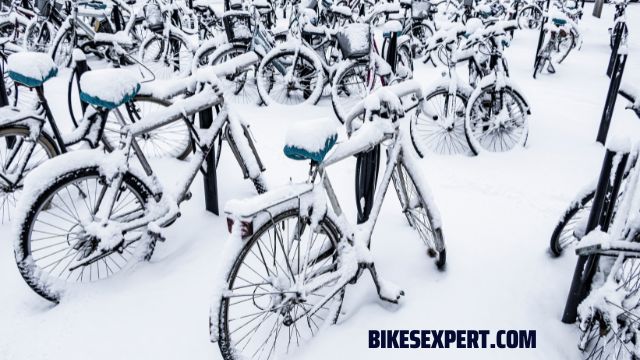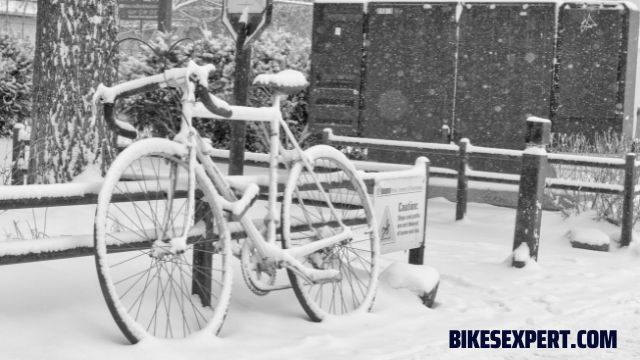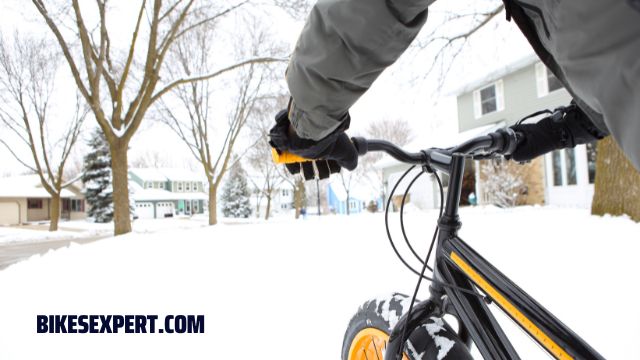In the winter, bicycle riding is dangerous. Winterizing your bicycle for the cold weather is important to ensure your safety.
The roads are often damp. The road muck gets sprayed over the delicate parts of your bike and on you. To keep yourself safe while riding your bike in the winter, you must winterize it. By winterizing your bike, you can:
- Ride your bike safely and smoothly
- Your bike will be protected from damage.
The following steps will make your winter bike riding experience much more enjoyable. In this article, I’ll discuss winterizing your bike for winter riding. Now let’s dig into the main topic.
Learn More: The 5 Best Bike Bags And Boxes Detailed Review In 2023.
Why Do You Need To Winterize Your Bike?

In harsh winter months, you may also have to deal with cold weather and moisture damaging your bike. Eventually, weather-related degradation will occur. For this reason, cyclists should always prepare their bicycles for cold weather in winter.
- Inflate your bicycle properly before riding.
- Keep your bike safe by checking the brakes and gears.
What Is Temp Too Cold To Cycle In Winter?
In temperatures below 32 degrees Fahrenheit, cycling is probably not a good idea. Consequently, ice can form on the road, increasing the risk of losing control, sliding, and being involved in a motorcycle accident.
Then How To Winterize Your Bike For Winter Cycling?

Winter can be harsh on your cycle, but you can ensure it runs smoothly with simple precautions. The following tips will help you prepare your bicycle for winter.
Put The Mudguards On
Using mudguards makes it easier to maintain a clean cycle and keep yourself clean. Mudguards protect your bike’s components from grit and dirt, extending their lifespan and keeping you safe on the roads.
Dirt can quickly enter your drivetrain and headset, and water can quickly rust your chain as it removes the lube. Full-cover mudguards will provide better protection for the bike and keep you more comfortable while riding.
Fenders
Fenders are essential during winter riding; without them, you’ll get covered in wet, grimy tire spray, and people behind you will, too. In rainy climates, these fenders follow the curve of the tire, but in snowy climates, they can clog. For heavy snow, clip-on fenders attached to your downtube or seatpost are better options
Braking Mechanism
Curved winter-specific pads improve winter braking and mud-shedding when using cantilever or V-brakes. Get sintered pads over organic pads to make your disc brakes more durable and work better in wet weather. You will wear out your brakes faster in winter due to grit and sand. You should replace your pads when they become worn out.
Use Wider, Puncture-Resistant Tires
Winter tires may cost more, but they are better at handling grit and thorns. These tires have more pronounced treads to improve traction on loose surfaces, such as wet leaf mush.
You can also choose tubeless tires.
- It might be easy to convert a tubeless-ready bike with tubeless-ready wheels and tires.
- Tubeless valves and sealants are expensive, and you’ll need to top up the sealant periodically.
You will drastically reduce your chances of getting a flat when you ditch your inner tubes. Tubeless tires are generally better at resisting penetration than summer tires with tubes. Check your tires for damage and make sure they are correctly inflated.
Get Your Chain Ready
It is even more important to lubricate your chain in cold weather regularly. When it’s raining or snowing mildly, use your favorite bike lube to keep your chain running smoothly.
For your bike chain, you must use wet lube in the winter. You can use a bar and chain lube in extreme cold weather . Bar and chain lube can make chains wear faster.
For winter you can use Muc Off Wet Lube This non-toxic chain lube is great for winter. Your bike’s chain will remain mud-free thanks to its water-repellent properties. Moreover, the brand is one of the most environmentally friendly on the market.

Furthermore, the advanced chemical formula prevents friction. Your bike will ride smoothly all winter long without squealing or squeaking from the chain.
Or Finish Line Wet Bike Lubricant also a good choice as winter bike chain lubrication. This product offers the best efficiency and pricing for every winter biker. During your ride, it will stay wet as well. Finish Line will protect your chain from wet, muddy and salty road mix, no matter how long or short your ride is.

These lube is water-repellent, so your bike chain will remain shiny throughout the winter. With the high viscosity synthetic oils and anti-wear additives present in the formula, your chain would be protected from extreme conditions.
Additionally, it guarantees a smooth drivetrain for quieter rides. You can say goodbye to creaky sounds from your bike with the finish line, wet bike lubricant. Your bike chain would be rust-free and always look great in winter weather.
Turn On Your Bicycle’s Lights
In winter, bicycle lights are important because the days are shorter. A front and rear light is essential when riding during limited daylight and low visibility conditions.
You can see what’s ahead in dimly lit areas with a front light. Choose a light that has at least 150 lumens. You don’t need a powerful front light if you commute in well-lit areas, 60 to 150 lumens is enough. Batteries can drain fast in cold conditions, so always carry a spare or two rear lights.
Maintain A Clean Bicycle
Dirt accumulates on bikes faster in cold weather. Furthermore, salty water causes corrosion between metal parts and carbon frames.
This means it needs to be cleaned regularly. Giving your bike a quick rinse after every wet ride with some water-dispersant spray and a re-lube is a good idea.
By doing this, everything will last longer and avoid rusting. The next time you ride your bike, a nicely polished bike will shed dirt more easily. A clean bike is also a fast bike.
Keep Your Bicycle Components Lubricated
During the winter, you should also change the lubricant in your chain. Winter riding requires wet lube, while summer riding requires lightweight dry lube. Also, lubricate the headset, the bottom bracket, the hubs, the freewheel, and the pivots on the rim brakes.
Also, you have to check out my post on How To Achieve The Perfect Bike Tire Pressure? Tips & Tricks To Ensure A Smooth Ride.
How To Dress For Winter Biking?

You must dress carefully for winter bike commuting – layering too much can cause you to overheat; too little can leave you feeling miserable. You can drive on the winter road with the right gear and a little willingness to experiment.
You Need Layers
Keep your core warm without overheating with a tight-fitting, breathable base layer. Wool and synthetics are breathable and moisture-wicking.
A Waterproof And Breathable Shell
In wet or cold conditions, it is ideal. Use a jacket with back vents or underarm zips that are seam sealed. Winter muck and road salt can damage ski shells and parkas in extreme cold.
Seam-Sealed Waterproof Pants
They are ideal for wet climates. A slim fit through the lower leg and ankle is ideal for pants with reflective elements.
Water- And Thermal-Resistant Cycling Tights
In cold weather, they perform well. Layer them over long johns with wool or breathable synthetic when it’s freezing.
Headwear
Headbands allow plenty of airflow while offering excellent ear protection and warmth. Wearing a slim beanie under your helmet will keep you warm in colder weather.
In extreme conditions, you can keep your neck, face, ears, and head warm with a balaclava. For commuters, neck warmers are a popular choice. Pulling up a breathable neck warmer to cover your chin when worn with a beanie or headband is possible.
Handwear And Gloves
Choose weather-resistant gloves with moderate to heavy insulation for colder temperatures. On the thumb, cycling gloves usually have a fleecy sniffle patch and leather or padded palms. If the temperature is extreme, you will need split-finger or lobster mitts. Shifting and braking are as easy as wearing gloves.
Socks, Shoe Covers And Footwear
- For added comfort, cycling socks are made of wool or synthetic material.
- Wear shoe covers or booties to keep your shoes dry and warm in wet climates.
- Insulated booties with a water-resistant shell are ideal for extreme temperatures.
- For short commutes, hiking boots are ideal. Many of them are water-resistant, warm, and offer good protection.
- It’s ideal for commuters and long winter rides to wear cycling shoes with gaiters, waterproof materials, and insulation.
Frequently Asked Questions [FAQs]
In this section of the article, we are going to answer some of the most commonly asked questions regarding Winterizing Bike.
What Do Bikers Wear In Cold Weather?
- During 50-degree weather, wear leg warmers, a light jacket, and light gloves. You can increase your comfort by wearing an insulated gilet, a headband, and overshoes.
- Use a waterproof and thermal jacket, footwear covers, and thermal bibs when the temperature drops below 45 degrees. Wear thicker gloves and a hat.
Is It Safe To Ride A Bicycle In The Winter?
In cold or snowy weather riding your bike is difficult . But, if you prepare your bike properly and gear up properly you can ride a bicycle safely in winter.
Can I Leave My Bike Out In The Winter?
It is best to avoid storing your bicycle outside during the winter. Cold weather, rain, and snow will cause your bicycle to rust and break down. If you want your bike to stay rust-free, keep it inside

Final Words:
This topic comes to an end. For a safe commute during winter, cyclists must take precautions and prepare.It is important to winterize and maintain your bike regularly in order to protect it from the harsh winter weather.
The frame, chains, brakes, and tires are particularly susceptible to mud and debris. When riding for long periods of time, wear protective gear and keep your bicycle clean. It is safe to cycle in the winter as long as you take some precautions.
Here is an article that I have written about How To Clean Your Bike Chain Without Removing It? – A Guide For A Smooth Ride.




